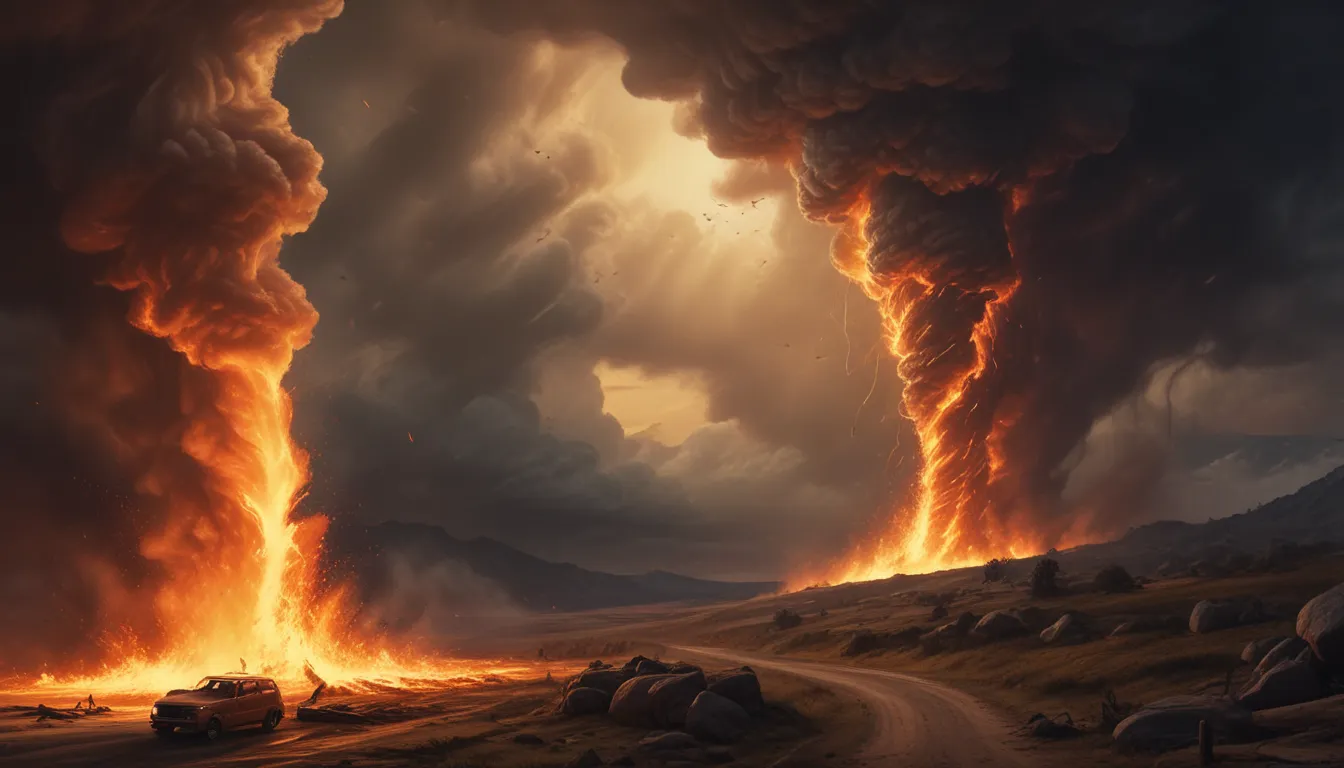The pictures we use in our articles might not show exactly what the words say. We choose these pictures to make you interested in reading more. The pictures work together with the words but don’t take their place. The words still tell you the important facts.
Welcome to a journey into the mesmerizing realm of fire tornadoes, where we unravel the mysteries surrounding these fiery whirlwinds. From their formation to their impact, join us as we delve into the captivating world of fire tornadoes and discover the awe-inspiring beauty and dangers they entail.
Understanding the Phenomenon of Fire Tornadoes
A fire tornado, also known as a fire whirl or firenado, is a rare weather phenomenon that emerges during wildfires, manifesting as a powerful vortex of flames resembling a tornado. These fiery whirlwinds exhibit swirling flames and intense heat, creating a mesmerizing yet hazardous spectacle.
Delving into the Formation of Fire Tornadoes
Fire tornadoes typically take shape under specific weather conditions characterized by high temperatures, low humidity, and strong winds. These rare phenomena often occur in large wildfires where the intense heat and updrafts foster the development of a vortex, leading to the creation of a fire tornado.
Exploring the Size and Height Variations
Fire tornadoes display a range of sizes and heights, varying from a few meters to several hundred meters tall. Their diameter can span from a few meters to tens of meters, showcasing the diverse scale of these extraordinary whirlwinds.
Unveiling the Intensity and Heat of Fire Tornadoes
Generating intense heat, fire tornadoes reach temperatures soaring to several hundred degrees Celsius. The combination of strong winds and extreme heat poses significant risks, making these phenomena immensely dangerous and destructive.
Recognizing the Unique Appearance and Structure
Fire tornadoes present as spinning columns of flames akin to traditional tornadoes. Driven upwards by powerful updrafts, the flames form a vertical rotating column amidst swirling winds, creating a mesmerizing yet perilous sight.
Factors Influencing Fire Tornadoes’ Behavior
Several factors influence the formation and behavior of fire tornadoes, including the size and intensity of the fire, wind patterns, terrain, and the availability of fuel sources. These variables determine the size, duration, and trajectory of a fire tornado, shaping its impact on the surrounding environment.
Understanding the Role of Fire Tornadoes in Fire Spread
Fire tornadoes play a vital role in accelerating the spread of wildfires by transporting burning debris and embers over long distances. This phenomenon can lead to the ignition of new fires ahead of the main fire front, exacerbating the overall devastation.
Addressing the Risks Faced by Firefighters
Fire tornadoes pose significant risks to firefighters engaged in combatting wildfires. The unpredictable nature of these phenomena, coupled with their intense heat and strong winds, poses challenges and dangers during firefighting operations.
Differentiating Fire Tornadoes from Atmospheric Tornadoes
While sharing similarities with atmospheric tornadoes in their swirling motion, fire tornadoes differ in their formation and cause. Atmospheric tornadoes stem from severe thunderstorms, whereas fire tornadoes arise from the intense heat and updrafts associated with wildfires.
Exploring the Terminology of Fire Tornadoes
The interchangeable use of “fire tornado” and “firenado” highlights the spinning vortex of flames witnessed during wildfires, encapsulating the captivating essence of these rare natural phenomena.
Historical Accounts and Pop Culture References
Fire tornadoes have been documented throughout history, with accounts tracing back centuries. Their awe-inspiring power has captured the imagination of filmmakers, artists, and writers, leading to their depiction in various forms of media.
The Significance of Studying Fire Tornadoes
Scientists and researchers study fire tornadoes to enhance understanding of their formation, behavior, and potential impacts. Their findings aid in improving firefighting techniques, risk assessment, and public safety measures in wildfire-prone areas.
Embracing Fire Tornado Safety Precautions
In the event of encountering a fire tornado or residing in an area at risk, adherence to safety guidelines provided by local authorities is crucial. These measures may involve evacuating the area, seeking refuge in fire-resistant structures, or relocating to safe zones away from the fire's path.
The Impact of Climate Change
The correlation between climate change and the frequency and intensity of wildfires underscores the importance of mitigating its effects on the occurrence of fire tornadoes. Addressing climate change is vital in safeguarding against the increasing risks posed by these fiery whirlwinds.
A Reflective Conclusion
As we navigate the enthralling realm of fire tornadoes, let us acknowledge their destructive potential and the need for vigilant precaution. By comprehending their formation, behavior, and influencing factors, we can work towards enhancing firefighting strategies, public safety measures, and fostering a deeper reverence for the wonders of nature. Stay informed, stay safe, and appreciate the awe-inspiring nature of fire tornadoes.
Frequently Asked Questions (FAQs)
Are fire tornadoes more dangerous than regular tornadoes?
While fire tornadoes and atmospheric tornadoes pose distinct risks, the former's intense heat and flame transport capabilities render them exceptionally hazardous. Atmospheric tornadoes, on the other hand, cause widespread damage through strong winds and debris.
Can fire tornadoes occur without wildfires?
Primarily emerging in wildfire contexts, fire tornadoes rely on the intense heat and updrafts associated with wildfires for their formation.
Can fire tornadoes form during controlled burns?
While more commonly linked to uncontrolled wildfires, fire tornadoes can manifest during controlled burns if conditions align. Controlled burns entail carefully managed fires utilized for land management and ecological purposes.
Can fire tornadoes be predicted?
Predicting fire tornadoes remains a challenge due to their intricate and dynamic nature. Nevertheless, advancements in fire behavior modeling and meteorological data analysis contribute to enhancing the understanding of fire tornado formation and behavior.
Can fire tornadoes extinguish themselves?
Fire tornadoes may naturally dissipate when the conditions supporting their formation undergo changes. Factors such as reduced wind speed, increased humidity, or diminished fuel availability can contribute to the organic dissipation of a fire tornado.
Embark on this enlightening journey into the captivating world of fire tornadoes, where understanding, appreciation, and safety converge to unveil the wonders and risks of these extraordinary natural phenomena. Stay informed, stay cautious, and immerse yourself in the awe-inspiring nature of fire tornadoes.






